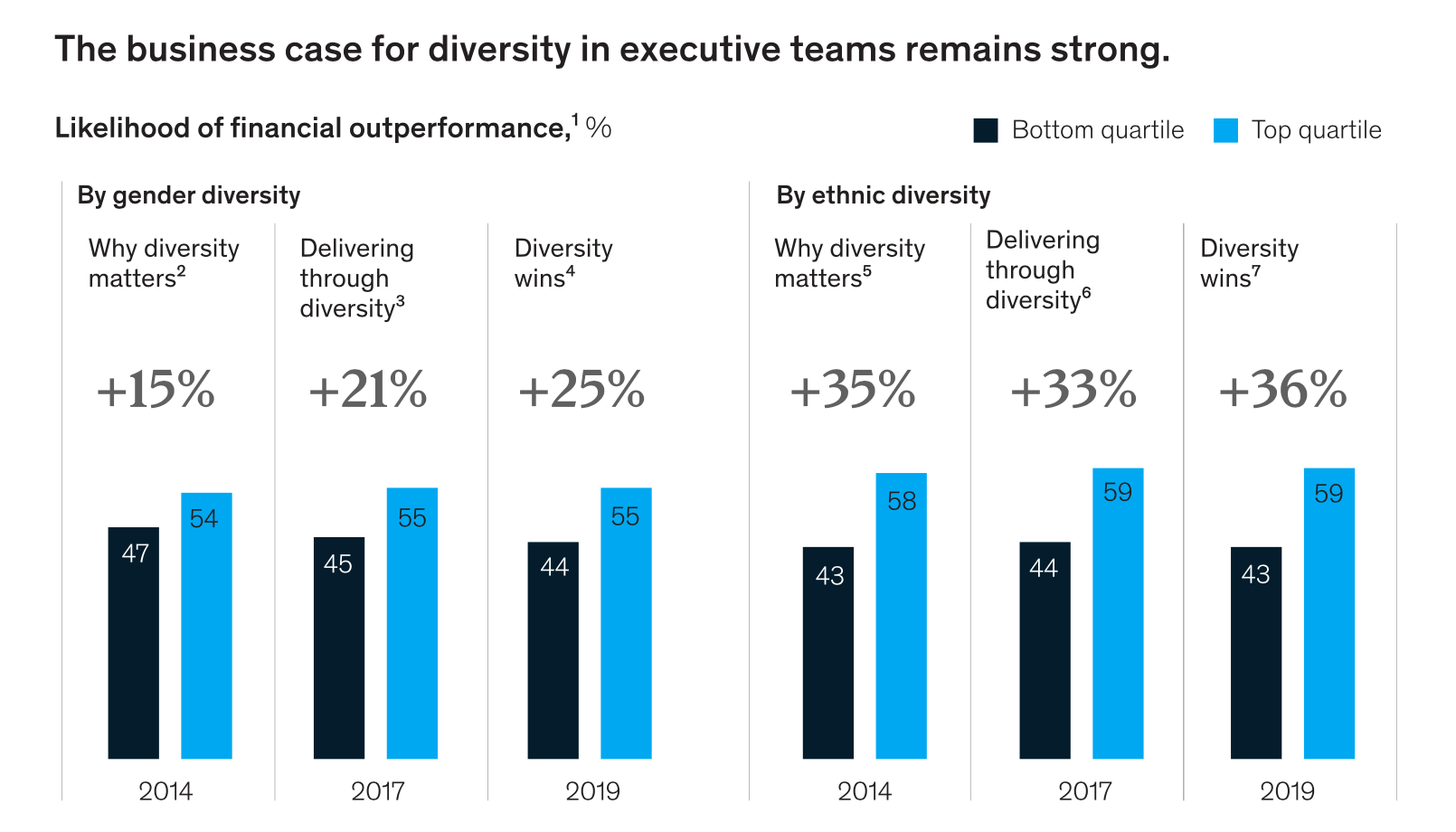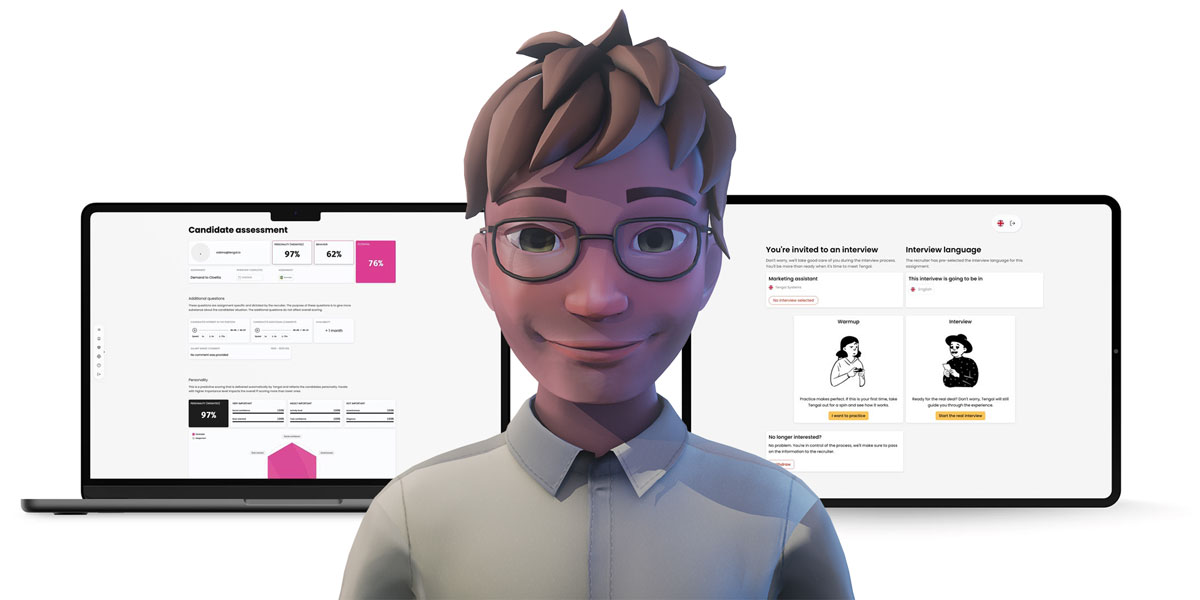Diversity hiring:
Everything recruiters need to know
In this guide, we’ll look at what diversity hiring really means, how to create a more inclusive hiring process and why it is so important.
Introduction
Diversity, equality, and inclusion (DE&I) have never been more important. Especially since organizations are seeing the value of having a diverse workforce to increase innovation, productivity, and overall profitability. But we believe that there is a big difference between diversity hiring and hiring for diversity. We want to show recruiters and hiring teams the benefits of not allowing unconscious biases to interfere with the recruitment process. Because when done right, unbiased hiring practices can promote openness and belonging. This leads to a more inclusive hiring approach, where candidates with the right competencies quickly can be identified. This is our take on diversity hiring.
The difference between hiring for diversity and diversity hiring
Today, we know that diverse companies perform better and are more profitable. But there are still many common misconceptions about how to become truly diverse. We believe that in order to create a company culture where people feel included, you need to start from the beginning.
Hiring for diversity is often referred to when companies recruit more diverse employees by simply cherry-picking candidates that seem diverse in comparison to the current state of employees. Diversity hiring, on the other hand, is should be the result of a fair recruitment process that is focused on fairness and selecting future colleagues based on their competencies. To do so it is especially important to eliminate unconscious biases from affecting the early stages of the recruitment process. So job-seekers can be assessed in a fair way. In addition to being a piece of the puzzle in creating sustainable results within your organization. When diversity hiring is a forced decision, it only leads to misplaced candidates who may not be the right fit for the role. What might benefit from a forced decision, however, is using unbiased recruitment methods so everyone in the process is aligned and involved.
Using the praxis of diversity hiring you will have a much wider range of candidates. They will be based on merit with special care taken to ensure procedures have reduced biases. Especially those related to the candidate's age or gender, the color of skin, religion, sexual orientation, and socioeconomic background. Or other personal characteristics that are unrelated to work performances.

Why is diversity recruitment important?
Not only does diversity within your organization increase your workforce’s range of skills, talents, and experiences. And as such, hiring for diversity will help you better understand your customers’ needs. The more diverse your workforce is, the greater the chances are that your employees will be able to cater to individual customer needs.
According to McKinsey & Company’s report Diversity Wins (2020), organizations with greater levels of diversity are reported to achieve better financially. As well as being more innovative and creative. Especially when given the right conditions and leadership. This should work as a motivation for every organization, regardless of which industry or size, to put considerable effort into creating a fair recruitment process.
"With Tengai we gained a scientific way to compare and select the best candidates. I'm convinced that Tengai will contribute to a more sustainable labor market"
Åsa Edman Källströmer, CEO at TNG
Tengai creates a more inclusive recruitment process
Tengai’s sole purpose is to assist recruiters and hiring managers to make objective assessments. Even though Tengai has certain human qualities to be relatable, she lacks the cognitive ability to judge. By eliminating gut feeling completely, a candidate’s age, sex, appearance, and dialect become irrelevant. While the goal of a human meeting is to charm one another, Tengai cannot be charmed since she only is measuring competency.
To ensure a fair assessment, Tengai conducts "blind interviews" and does not have any access to candidates' personal data before, during, or after the interview. Our AI never uses facial recognition software to remove any possible discrimination based on appearance.

How is the Tengai interview?
of candidates think Tengai reduces the risk of discrimination
of candidates think Tengai enhances the hiring process
of candidates would like to be interviewed by Tengai again
"We developed Tengai's interview to be rewarding, efficient, and convenient for candidates."
Sinisa Strbac, CPO at Tengai
Can bias affect you during a job interview?
In the hiring process, unconscious bias happens when you form an opinion about candidates based solely on first impressions. Or, when you prefer one candidate over another simply because the first one seems like someone you’d easily hang out with outside of work. Even in the early hiring stages, a candidate’s resume picture, name, or their hometown could influence your opinion more than you think. In short, unconscious bias influences your decision – whether positively or negatively – using criteria irrelevant to the job.
But (un)conscious bias is costing you money and talent. Because biased hiring decisions result in less diverse teams and less diversity hinders your business productivity. Once you start researching the benefits of diversity hiring, you will find article after article and research piece after research piece that says businesses perform better when they have greater ethnic and gender diversity. Ultimately, more diverse companies produce more revenue.
Ultimate guide for recruiters
Here is a free guide with tips and tricks on how to create a more unbiased hiring process.
Tengai is validated
Psychometric experts tested Tengais interview analytics and methods.
How to avoid interview bias
1. Consider your hiring goals
Being mindful of interviewing biases is an important part of avoiding them in your own hiring processes. It can help to consider your own hiring goals and specifically identify equitable hiring and interviewing practices you’d like to maintain before entering the interview setting.
2. Recruit broadly
When you know your own goals and objectives in interviewing, you can use an array of strategies to begin meeting them. Recruiting from a variety of locations and backgrounds, for example, can help diversify your candidate pool and avoid interviewing biases.
3. Use multiple interviewers
Next, set up conversations using multiple interviewers with specified questions. This can help alleviate the affects of any one individual’s biases in interviewing.
4. Anonymize when possible
If at all possible, keep parts of the interview process anonymous. If your candidates must complete a test, for example, keep the names and profiles of individuals separate from their test results as long as you are able.
5. Develop structured, open-ended questions
Standardize your questions and questioning processes wherever possible. You might do this by providing every interviewer with an interview guide and a set of questions to use in their discussions. Try providing training for interviewers on avoiding bias, as well.
Conclusion: Find hidden talent with Tengai
If you're looking to create a more diverse recruitment strategy, then conversational AI is the way to go. Tengai can help you provide exceptional conversational AI that engages job seekers throughout the process and delivers structured interview data to recruiters. Book your own walk-through demo.
Learn more on the Tengai blog
The AI Advantage: Enhancing Job Applications with Technology
29 May, 2024In recent discussions across the hiring landscape, a controversial topic has emerged: the use of AI by candidates in the...
News In Tengai Recruting Hub
22 May, 2024In recruitment, the initial stages often involve a myriad of mundane tasks that can slow down the process. At Tengai, we...
Navigating Ethical AI Deployment
17 May, 2024In the modern workplace, ethical considerations surrounding artificial intelligence (AI) deployment are paramount. A rec...

